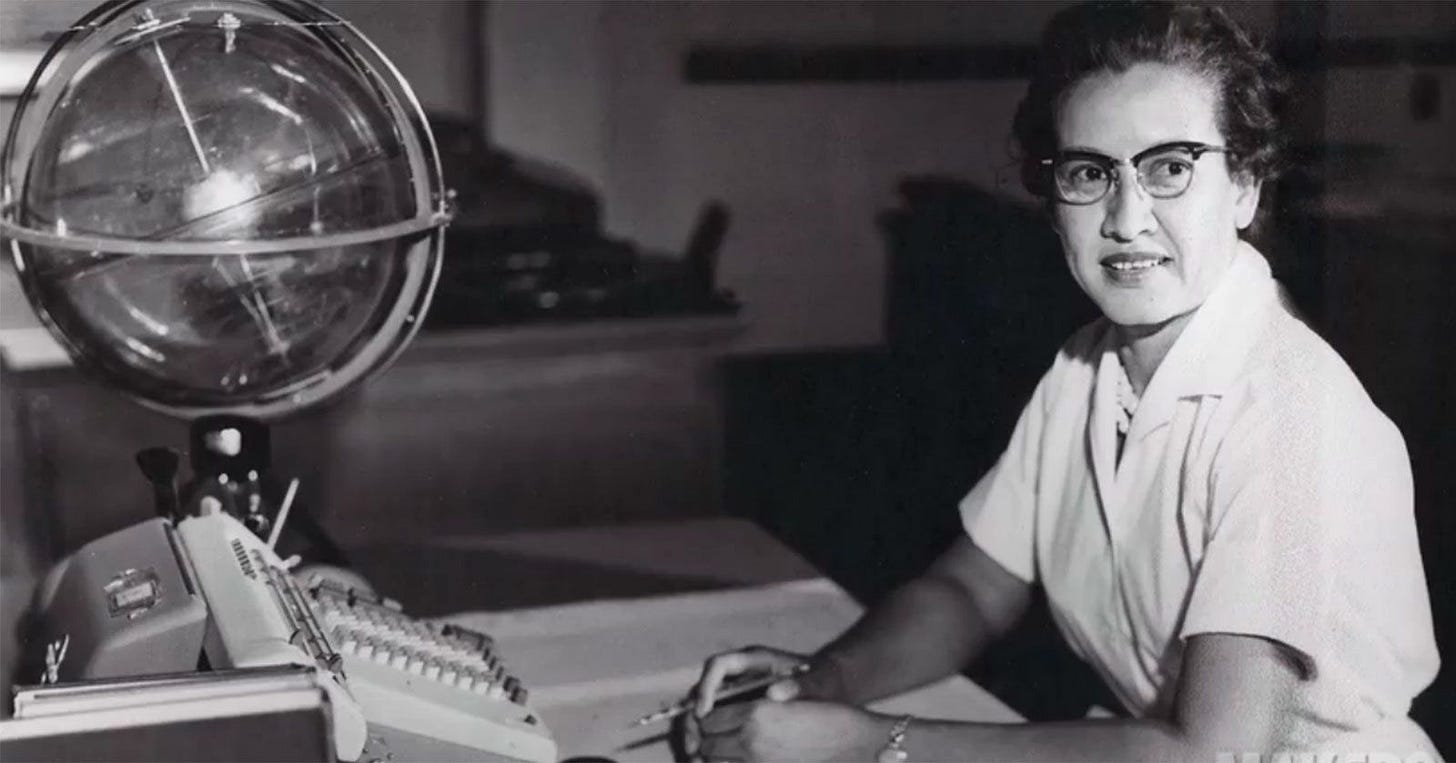Make Yourself Indispensable
Katherine Johnson became irreplaceable by becoming the human error-checker.
I won’t fly unless she says so.
It’s February 20th, 1962, Cape Canaveral Florida.
The US has been waiting for the first American to orbit the Earth, but after months of delays the clouds parted finally. Weather is clear. Astronaut John Glenn will launch in Mercury-Atlas 6 also called the "Friendship 7" rocket and be the first American to orbit the Earth.
Compared to previous test runs, everything matched. Conditions were perfect, even the new electronic computers gave the viable answers. It’s a go for launch.
But Glenn is waiting on the approval of 1 woman: Katherine Johnson.
“If she says the numbers are good, I am ready to go”
Katherine Johnson was one of NASA’s computers. Women who hand-calculated various trajectories, fluid dynamics, and other essential data points, similar to Mary Jackson’s work in the wind tunnel lab.
Johnson was the human-error checker. Despite having new electronic computers who could spit out the answers faster than Johnson, Glenn didn’t trust them. He always wanted Johnson to double check the numbers.
Johnson became the last word for orbital safety.
The Girl Who Loved to Count.
Katherine Johnson wasn’t a physicist. She wasn’t even called an engineer.
Her title: Computer.
Born in a West Virginia in a town with no education past 8th grade. TO her parents, she was the girl who loved counting. By age 10, Johnson enrolled in high school. Graduated high school at 14, College at 18. Took every math course available to her. Dr. W. W. Schieffelin Claytor, one of her professors, even created special advanced math courses just for her, such as analytic geometry which would help her stand out at NASA.
She was a mathematical genius.
In 1952, she applied to the all-Black West Area Computing section, led by Dorothy Vaughan. She excelled at her job. Checking trajectories for missions and leading teams of other computers even though her position of “computer” was not much higher than a secretary or janitor.
On May 1st, 1961, Alan Shepard became the first American in space. It launched into space and landed safely in the Atlantic Ocean. What millions didn’t know at the time was the Katherine did the calculations for Shepard’s launch by hand.
She became the go/no-go for any launch from the first crewed spaceflight to the Moon landings, and to the beginning of the Space Shuttle program.
When the machines were wrong, she was right.
When the machines were right, she confirmed it.
She became the human safety net for the most dangerous missions on Earth.
Why Glenn Waited
Here's what's wild about Katherine's story. NASA had electronic computers that could calculate faster than any human. But Glenn still waited for her approval.
Because Katherine had built something more valuable than speed: she was right. Every time.
Here’s how this worked.
NASA would run the electronic calculations.
Get their numbers. Then they'd call Katherine over:
"Tell her to check and see if the computer trajectory they had calculated was correct."
She'd check the computer’s math. Usually, it was right. But the process wasn't about the math anymore.
The process was about Katherine.
When you're right consistently enough, people stop asking why and start asking when.
How Katherine Became Irreplaceable
Katherine didn't compete with computers on speed. She couldn't. They were faster.
But she could be more reliable.
While machines calculated faster, she became the person who said whether those calculations were worth betting a life on.
She kept detailed records of everything. Every calculation. Every decision. Every piece of reasoning. When people questioned her work, she could walk them through exactly why she did what she did.
More importantly, she positioned herself as the final safety check. She wasn't just doing math. She was the last person to touch the numbers before someone's life depended on them.
And every time she verified a calculation correctly, every time the mission succeeded, she built more trust. Eventually, important decisions couldn't happen without her approval.
The Human Element Machines Can't Replace
Katherine figured out something crucial: she didn't need to be faster than computers. She needed to be something they couldn't be.
A human who could look at numbers and say, "This feels wrong" or "This looks right."
The problem with computers at the time was they spoke in machine code, not human-readable code like we see today. We had to make the computers learn human language rather than force people to learn computers.
Because machines can calculate, but they can't judge. They spit out numbers, data, and words without context.
Look at what Glenn actually said: "If she says the numbers are good, I am ready to go."
Not "if the computer says." Not "if the engineers confirm."
If Katherine says.
That's trust built through being right when it mattered most.
Your Opportunity
Every technical field is having its Katherine Johnson moment right now. AI and automation are getting better at the calculation part.
But they're creating new needs for human judgment and verification.
The question isn't whether machines will do your calculations faster. They will.
The question is: will you be the person they check with before making irreversible decisions?
Katherine became irreplaceable not because she was the fastest computer, but because she was the most reliable human interface between calculation and catastrophe.
Glenn didn't wait for the machine to say go. He waited for Katherine.
Become the person they wait for.


